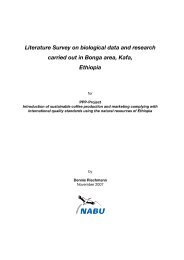Flora Biodiversity Assessment in Bonga, Boginda and Mankira Forest
Flora Biodiversity Assessment in Bonga, Boginda and Mankira Forest
Flora Biodiversity Assessment in Bonga, Boginda and Mankira Forest
You also want an ePaper? Increase the reach of your titles
YUMPU automatically turns print PDFs into web optimized ePapers that Google loves.
Class <strong>Bonga</strong> Bog<strong>in</strong>da <strong>Mankira</strong><br />
A=I 65 40 33<br />
B=II 2 7 11<br />
C=III 0 5 1<br />
D=IV 0 1 1<br />
E=V 0 0 0<br />
Figure 19. Frequency class <strong>and</strong> number of species <strong>in</strong> each frequency class <strong>and</strong> forest area<br />
The result of this current survey <strong>in</strong>dicates absence of constantly present species<br />
with<strong>in</strong> the three forest sites which leads to the conclusion that the forests have a<br />
heterogeneous species composition (figure 19). Croton macrostachyus <strong>in</strong> <strong>Mankira</strong>,<br />
Milletia ferrug<strong>in</strong>ea <strong>in</strong> <strong>Bonga</strong> <strong>and</strong> Bog<strong>in</strong>da are the most present species. In this study<br />
there was no s<strong>in</strong>gle tree or shrub species that is constantly present with<strong>in</strong> the three<br />
study sites. This is probably due to favorability of the environment to accommodate<br />
different species. Hence except for few <strong>in</strong>dividual species there was not much<br />
predom<strong>in</strong>ance everywhere. With regard to density, the most populous trees above 10<br />
cm diameter <strong>in</strong> <strong>Mankira</strong>, <strong>Bonga</strong> <strong>and</strong> Bog<strong>in</strong>da are summarized <strong>in</strong> the follow<strong>in</strong>g Table<br />
(Table 9).<br />
52



